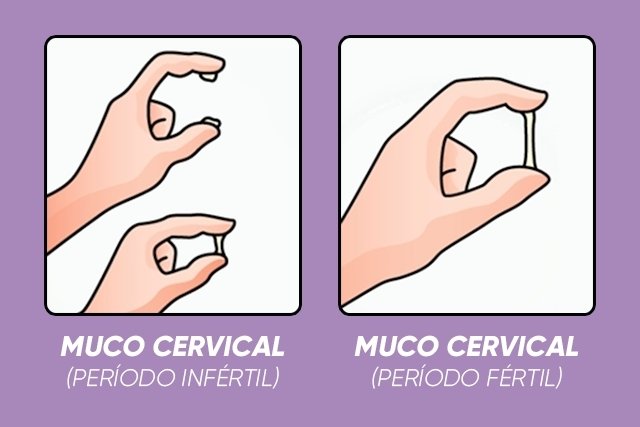Cervical mucus is a liquid secretion produced by the cervix and its function is to prevent bacteria and viruses from entering the uterus, keeping it healthy, in addition to increasing lubrication, protecting sperm from the acidic environment of the vagina and helping sperm. to reach the uterus during the fertile period.
Cervical mucus normally appears on underwear as a type of transparent, white or slightly yellowish discharge, with no odor, being a natural secretion of the body and its characteristics may vary throughout the menstrual cycle and during pregnancy.
When vaginal discharge has a color, smell, thicker or different consistency than usual, it may indicate the presence of a problem and therefore it is important to consult a gynecologist to better evaluate it, carry out tests and advise appropriate treatment. See what each discharge color means.
Characteristics of cervical mucus

The characteristics of cervical mucus may vary throughout a woman’s life, according to the phase of the menstrual cycle:
1. Beginning of the menstrual cycle
The beginning of the menstrual cycle is the first day of menstruation and the hormones estrogen and progesterone that regulate the menstrual cycle and the production of cervical mucus are low and, therefore, in this phase, which can last from 1 to 5 days, the amount of Cervical mucus is very low and cannot be noticed.
2. After menstruation
Soon after menstruation, generally from days 5 to 9 of the menstrual cycle, the amount of estrogen begins to increase, but the production of cervical mucus is still low and the vagina normally appears drier at this stage.
However, as the most fertile days approach, the mucus tends to become creamier, moister and whiter, with a consistency similar to yogurt.
3. Fertile period
The fertile period is the 6 days surrounding ovulation and generally begins between 10 and 14 days after the first day of menstruation. Learn how to calculate ovulation day.
At the beginning of this phase, there is a gradual increase in estrogen and the production of cervical mucus, which appears thicker, stickier and whitish. On the days of ovulation, the vagina becomes more humid and the cervical mucus becomes more crystalline, transparent and elastic, similar to egg white, and therefore, the presence of this mucus indicates that the woman is fertile.
Cervical mucus during the fertile period is important to increase the lubrication of the vagina and help sperm enter the vaginal canal to reach the egg, facilitating fertilization.
The analysis of the characteristics of cervical mucus is widely used to indicate the fertile period and this analysis is called the cervical mucus method or Billings method. See how to use the Billings method.
4. After the fertile period
After the fertile period until the next menstruation, there is an increase in progesterone, a hormone that prepares the uterus for a possible pregnancy, and estrogen levels decrease. At this stage, the amount of cervical mucus is very low or absent and may appear more sticky or viscous.
5. Menopause
Menopause is marked by the end of a woman’s reproductive phase and occurs because the ovaries stop producing estrogen and, therefore, the production of cervical mucus decreases and the vagina becomes drier. Furthermore, despite little, the mucus may become thicker and the odor may change. Therefore, you should follow up with a gynecologist to assess changes in cervical mucus during menopause and the need for hormone replacement or another type of treatment. Check out other changes that occur during menopause.
Cervical mucus in pregnancy
During pregnancy, cervical mucus becomes thicker and whiter due to the normal hormonal changes during this period. Thus, it forms a barrier that serves as a defense to prevent bacteria or other microorganisms from developing inside the uterus and creating complications during pregnancy. Check out other changes that occur in a pregnant woman’s body to adapt to the arrival of the baby.
Postpartum cervical mucus
After birth, the body undergoes a natural process of eliminating remnants of blood, mucus and tissue from the placenta for 3 to 6 weeks, as this is the phase in which the uterus contracts to return to its normal size.
At this stage, the vaginal mucus has specific characteristics according to the postpartum period, generally showing blood during the first few days, becoming brownish with bursts of blood from the 3rd to the 10th day and yellowish or whitish from the 10th day onwards. See other changes in the body in the postpartum period.
It is important to always follow up with your gynecologist to ensure a smooth postpartum recovery.
How to assess cervical mucus
To assess cervical mucus, a woman should insert her index finger into the vagina to observe the secretion in this region. When removing the finger, you should check whether the mucus is present in sufficient quantity and whether it is elastic or not. The ideal way to get pregnant is to have a good amount of mucus and that it is elastic.
Assessment of cervical mucus should not be used as a contraceptive method to prevent pregnancy because the mucus may undergo small variations throughout the cycle, making its exact assessment difficult. Check out other contraceptive method options that may be safer and more effective.
Possible changes
Some women who have difficulty getting pregnant may have very thick cervical mucus throughout the cycle, which prevents the movement of sperm and, therefore, should see a gynecologist to start appropriate treatment.
Furthermore, cervical mucus may have a thicker consistency when using contraceptives due to ovulation and the normal hormonal changes of the menstrual cycle not occurring.
Other situations that can alter the consistency, color, volume and smell of cervical mucus are hormonal changes, changes in the bacterial flora of the vagina or sexually transmitted infections, for example. These changes can cause vaginal discharge and should always be evaluated by a gynecologist. Find out what each color of vaginal discharge means.

Sign up for our newsletter and stay up to date with exclusive news
that can transform your routine!
Warning: Undefined array key "title" in /home/storelat/public_html/wp-content/plugins/link-whisper-premium/templates/frontend/related-posts.php on line 12
Warning: Undefined array key "title_tag" in /home/storelat/public_html/wp-content/plugins/link-whisper-premium/templates/frontend/related-posts.php on line 13




